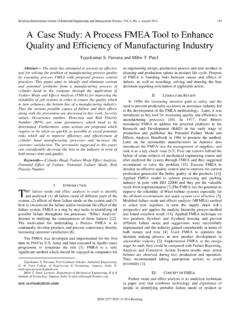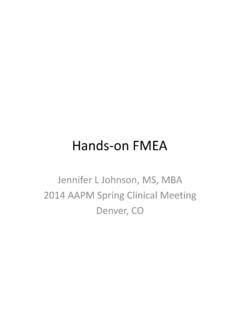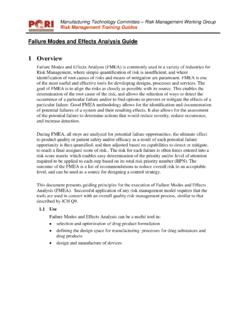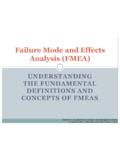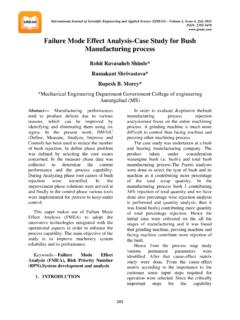Transcription of FMEA Failure Mode and Effects Analysis - ewh.ieee.org
1 FMEAFMEAF ailure Mode and Effects AnalysisA Risk and Reliability Assessment ToolAngelo ScangasQuality Support Group, me, whatcould go wrong?FMEAYour objectives?FMEA11/14/2011 Quality Support Group, Inc. All rights reserved3 The Challenge Effectivelyapply and sustainthe FMEA Methodology as a Risk and Reliability Assessmenttool. Integral part of your Preventive Actionprocess. FMEAFMEA Objective The goal of FMEA is to preventquality, reliability and safety problems. Most effective when used earlyduring product design and manufacturing process Concepts of Risk The consequences/severity(S) of that Failure how severe it might be to the stakeholders The probability(O) of occurrence of Failure how often the Failure may occur The ability to preventthe Failure from occurring or detectthe Failure (D) followed by action to prevent any effect on the stakeholdersFMEA11/14/2011 Quality Support Group, Inc. All rights reserved6 Product Development ProcessFMEAQ uality Support Group, Concept Requirements Reliability goal determination Ensures that reliability will get a proper attention during development Product usage profile Must be set in the concept phase as a basis for all modeling and reliability analysesFMEAQ uality Support Group, definition and preliminary design Reliability goal included into the product spec.
2 Ensures that reliability becomes part of the design engineering Reliability requirements for key components Provide supply engineering with guide to select manufacturers of reliable and quality componentsFMEAQ uality Support Group, scale design Reliability estimate, using any or a combination of reliability assessment methods including Failure mode and Effects Analysis IEC60300-3-1, Reliability methods Key components selection for reliability Review of components life test data or mechanical Analysis Failure mode mitigation, reliability growth Re-assess reliability for resultant changes, plot and monitor reliability growthFMEA11/14/2011 Quality Support Group, Inc. All rights reserved10 OVERVIEW OF THE FMEA PROCESS Define the scope of the FMEA to be conducted. Select the FMEA team. Review Design Intent (DFMEA) or Design Intent & Process Function (PFMEA) Product -Marketing Plan Product -Design goals Process Flowchart Process function Historical data Other informationFMEA11/14/2011 Quality Support Group, Inc.
3 All rights reserved11 OVERVIEW OF THE FMEA PROCESS Identify all Failure modes & the corresponding Effects . Rate the relative riskof each Failure mode and effect . Severity Identify all potential causes. Rate the relative riskof each cause. Occurrence Identify all current design (DFMEA) or process (PFMEA) controls to prevent or detect the Failure mode. Rate the relative riskof all controls. Detection/Prevention Prioritize for action. Calculate the RPN (Risk Priority Number). Use the Pareto Principle. Take action and validate action effectiveness. Calculate the resulting Support Group, Inc. All rights reserved12 DetectPreventRPNDETOCCSEVA ctionTakenAction ResultsResponse &TragetCompleteDateRecommendedActionsRPN D etecCurrentDesignControlsOccurPotentialC ause(s)/Mechanism(s)Of FailureClassSevPotentialEffect(s) ofFailurePotential FailureModeItem / DetectPreventRPNDETOCCSEVA ctionTakenAction ResultsResponse &TragetCompleteDateRecommendedActionsRPN D etecCurrentControlsOccurPotentialCause(s )/Mechanism(s)Of FailureClassSevPotentialEffect(s) ofFailurePotential FailureModeItem /DesignIntent FMEA11/14/2011 Quality Support Group, Inc.
4 All rights reserved13 Design (Product) FMEA Led by Design Engineer Does not rely on process controls to overcome potential weaknesses in the design Does take into account the technical/physical limits of the manufacturing processFMEA11/14/2011 Quality Support Group, Inc. All rights reserved14 Normally led by a member from Quality, Manufacturing Engineering or Process Engineering team. The Process FMEA assumes the product as designed will meet the design intent. Process FMEA must meet product design intent and process FMEAFMEAS y s te mM o d u l e 1M o d u l e 2S u b - m o d u l e 1 AS u b - m o d u l e 2 AS u b - m o d u l e 2 BS u b - m o d u l e 1 BS u b - m o d u l e 1 CS u b - m o d u l e 2 CS u b - m o d u l e 2 DM o d u l e 3S u b - m o d u l e 3 AS u b - m o d u l e 3 BS u b - m o d u l e 3 CS u b - m o d u l e 3 DM o d u l e 4F M E C A R e q dLevels of Analysis -Scope of the FMEAR eliability apportionment-type block diagram.
5 Describe the function and performance specifications for each block FMEA11/14/2011 Quality Support Group, Inc. All rights reserved16 DetectPreventRPNDETOCCSEVA ctionTakenAction ResultsResponse &TragetComp leteDateRecommendedActionsRPND etecCurrentProcessControlsOccurPotential Cause(s)/Mechanism(s)Of FailureClassSevPotentialEf f ect(s) ofFailurePotential FailureModeIte m / Process StepDetectPreventRPNDETOCCSEVA ctionTakenAction ResultsResponse &TragetComp leteDateRecommendedActionsRPND etecCurrentProcessControlsOccurPotential Cause(s)/Mechanism(s)Of FailureClassSevPotentialEf f ect(s) ofFailurePotential FailureModeIte m / Process StepFunctionCriticalFMEA11/14/2011 Quality Support Group, Inc. All rights reserved17 Process Function & Design Intent (PFMEA)Process Function & Design Intent (PFMEA)Design Intent Requirements (5Cs): Critical To Quality Critical To Application Critical To Customer Critical To Process Critical To Safety/Regulatory Compliance FMEA11/14/2011 Quality Support Group, Inc.
6 All rights reserved18 DetectPreventRPNDETOCCSEVA ctionTakenAction ResultsResponse &TragetComp leteDateRecommendedActionsRPND etecCurrentProcessControlsOccurPotential Cause(s)/Mechanism(s)Of FailureClassSevPotentialEf f ect(s) ofFailurePotential FailureModeIte m / Process StepDetectPreventRPNDETOCCSEVA ctionTakenAction ResultsResponse &TragetComp leteDateRecommendedActionsRPND etecCurrentProcessControlsOccurPotential Cause(s)/Mechanism(s)Of FailureClassSevPotentialEf f ect(s) ofFailurePotential FailureModeIte m / Process StepFunctionFMEA11/14/2011 Quality Support Group, Inc. All rights reserved19(D) Manner in which a component, subsystem or product could fail to meet design intent(P) Manner in which the process could fail to meet the process function and design intentUsing this definition a Failure does not need to be readily detectable by a customer to still be considered a Failure ModePotential Failure ModeFMEA11/14/2011 Quality Support Group, Inc. All rights reserved20 Types of Questions to ask How can the product or process fail to meet specifications?
7 Regardless of the engineering/requirement specs, what would the customer consider objectionable? When this operation is being done, what could go wrong? Or, what tends to go wrong?FMEA11/14/2011 Quality Support Group, Inc. All rights reserved21 DetectPreventRPNDETOCCSEVA ctionTakenAction ResultsResponse &TragetComp leteDateRecommendedActionsRPND etecCurrentProcessControlsOccurPotential Cause(s)/Mechanism(s)Of FailureClassSevPotentialEf f ect(s) ofFailurePotential FailureModeIte m / Process StepDetectPreventRPNDETOCCSEVA ctionTakenAction ResultsResponse &TragetComp leteDateRecommendedActionsRPND etecCurrentProcessControlsOccurPotential Cause(s)/Mechanism(s)Of FailureClassSevPotentialEf f ect(s) ofFailurePotential FailureModeIte m / Process StepFunctionVoice of the CustomerFMEA11/14/2011 Quality Support Group, Inc. All rights reserved22 Determine the Effects of potential EffectsPotential EffectsEffects of the Failure mode on the external and internal customerFMEA11/14/2011 Quality Support Group, Inc.
8 All rights reserved23 Severity Ranking Rating of 1 to 10 with 10 being the most severe impact. Use a scale. Use the same scale throughout. To assign this rating, must assume the Failure mode has occurred. Assign severity rating for every possible effect . Understand customer Effects Understand internal effectsA Severity 9 or 10 must have preventive actionFMEAQ uality Support Group, Automotive, SAE FMEA , SAE J-1739: Severity TableSeverity Criteria Ranking Non e No disc ernibl e ef f ect. 1 Very Min or Fit and f inish/s queak and r attl e item does not conf orm. D ef ect notic ed b y discriminating custom ers (l ess than 25 %). 2 Minor Fit and f inish/s queak and r attl e item does not conf orm. D ef ect notic ed b y 50 % of c us tomers. 3 Very l ow Fit and f inish/s queak and r attl e item does not conf orm. D ef ect notic ed b y m ost c us tomers (great er than 75 %). 4 Low Vehicl e/it em op er abl e but c omf ort/c onveni enc e it em(s) op er ab le at a reduced l evel of perf or mance.
9 Cus t om er s om ewhat dis satis f ied. 5 M od er at e Vehicl e/it em op er abl e but c omf ort/c onveni enc e it em(s) inoper abl e. Cus tom er dissatisf ied. 6 High Vehicl e/it em op er abl e but at a r educ ed l evel of perf orm anc e. Custom er ver y dissatisf ied. 7 Very High Vehicl e/item inop er ab l e (l oss of primar y f unction) 8 Haz ardous with warning Ver y hi gh severit y r anki ng when a pot enti al f ailur e m od e af f ec ts saf e vehicle oper ati on and/ or i n vol ves n on-com pli anc e with govern ment r egul ati on with warning. 9 Haz ardous with warning Very hi gh severit y r anki ng when a pot enti al f ailur e m od e af f ec ts saf e veh icle oper ati on and/ or i n vol ves n on-com pli anc e with govern ment r egul ati on with out warning. 10 FMEA11/14/2011 Quality Support Group, Inc. All rights reserved25 DetectPreventRPNDETOCCSEVA ctionTakenAction ResultsResponse &TragetComp leteDateRecommendedActionsRPND etecCurrentProcessControlsOccurPotential Cause(s)/Mechanism(s)Of FailureClassSevPotentialEf f ect(s) ofFailurePotential FailureModeIte m / Process StepDetectPreventRPNDETOCCSEVA ctionTakenAction ResultsResponse &TragetComp leteDateRecommendedActionsRPND etecCurrentProcessControlsOccurPotential Cause(s)/Mechanism(s)Of FailureClassSevPotentialEf f ect(s) ofFailurePotential FailureModeIte m / Process StepFunctionRoot Cause AnalysisData FMEA11/14/2011 Quality Support Group, Inc.
10 All rights reserved26 Determine the potential causes of each of potential Failure . What are the potential causes of the Failure mode?A cause and effect (fishbone) diagram may be helpful CausesPotential Causes(D) An indication of a design weakness resulting in the Failure mode (Material failures, Incorrect Assumptions, Design Errors, Component Selection Errors, etc.)(P) How the Failure could occur during production (Human Error, Equipment Error, Calibration IssueImproper mold set-up, Insufficient shot size, mold temperature too high, etc.)FMEA11/14/2011 Quality Support Group, Inc. All rights reserved27 DetectPreventRPNDETOCCSEVA ctionTakenAction ResultsResponse &TragetComp leteDateRecommendedActionsRPND etecCurrentProcessControlsOccurPotential Cause(s)/Mechanism(s)Of FailureClassSevPotentialEf f ect(s) ofFailurePotential FailureModeIte m / Process StepDetectPreventRPNDETOCCSEVA ctionTakenAction ResultsResponse &TragetComp leteDateRecommendedActionsRPND etecCurrentProcessControlsOccurPotential Cause(s)/Mechanism(s)Of FailureClassSevPotentialEf f ect(s) ofFailurePotential FailureModeIte m / Process StepFunctionFMEA11/14/2011 Quality Support Group, Inc.
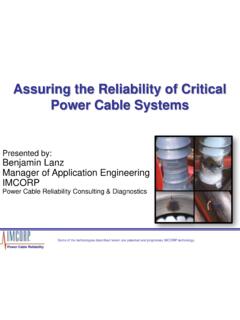
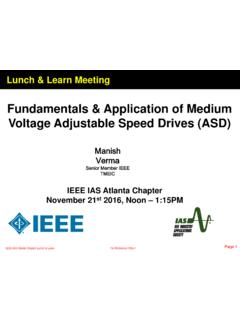
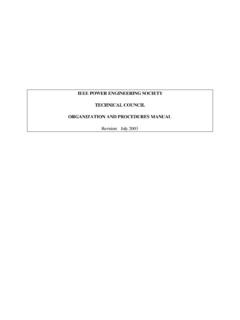
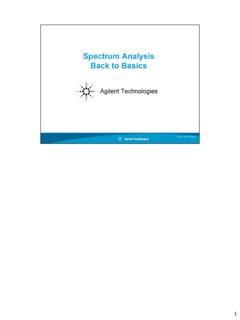
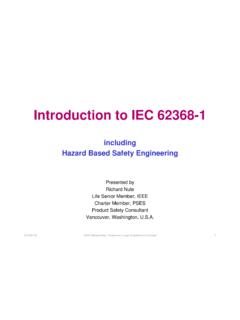

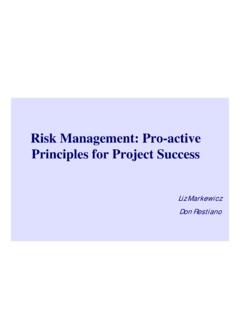
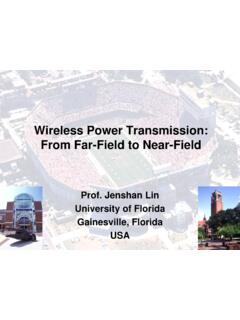
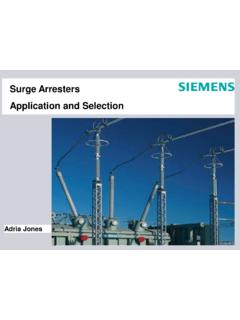
![Wind Farm Electrical Systems.pptx [Read-Only] - IEEE](/cache/preview/8/3/4/a/7/7/3/b/thumb-834a773be91d444a92c541b6bc1b2269.jpg)



